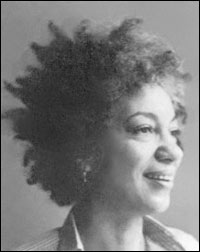It looks like a collection of nuclear cooling towers, suddenly plopped into Harlem, but June Jordan’s plan for a redevelopment of Harlem in the early 1960s was for a collection of conical high rises:

Esquire Magazine had the (above layout) which was recently featured in an article in The New Yorker.
The conical towers would have concentrated a huge number of residents in towers that would have dwarfed even the larger Harlem and East Harlem projects that you can see in the image (above).

June Jordan (the architect pictured above), sought to throw:
herself into what she called “a collaborative architectural redesign of Harlem,” in which she joined forces with the architect R. Buckminster Fuller, champion of the geodesic dome. Jordan and Fuller called their collaboration “Skyrise for Harlem”: a plan for public housing that was attuned to the well-being of two hundred and fifty thousand of the neighborhood’s residents, most of them Black. The project may have seemed a left turn for Jordan, who came to prominence through her essays and poetry. But she had always conceived of her work as falling under the umbrella of environmental design—“that is,” she explained, “in general, an effort to contribute to the positive changing of the world.”
While C. L. Davis II, from Buffalo, NY questions whether or not June Jordan can be classified as an architect in Race and Architecture: https://raceandarchitecture.com/2013/11/26/writing-and-building-black-utopianism-representing-the-architextural-musings-of-june-jordans-his-own-where-1971/, her bold proposal clearly situated her work in the Le Corbusier > Robert Moses > Buckminster Fuller school of slum clearance > towers in the park, school:

Note the scale of the brownstones and tenaments below one of the towers, sectionally represented.
Jordan believed that the grid pattern was responsible for high crime rates, and that The Commissioners’ Plan was “pathological crucification.” [Fish, C. (2007). Place, Emotion, and Environmental Justice in Harlem: June Jordan and Buckminster Fuller’s 1965 “Architextual” Collaboration. Discourse].

Fuller and Jordan’s “Skyrise” never made it off the pages of Esquire. The ARCH plan for the East Harlem Triangle was never adopted, though Goldstein argues that it did lead the way for residents to build “a social service center and hundreds of affordable housing units in the following years.” Without any radical reconstruction, most of Harlem foundered, the area’s real estate prices plummeting in the 1970s as in so many other economically disadvantaged neighborhoods across the five boroughs. In the 1980s, gentrification tentatively arrived in Harlem, mostly by way of middle-class black residents who, as Monique M. Taylor writes in “Can You Go Home Again? Black Gentrification and the Dilemma of Difference,” were looking for “real estate bargains” while also being “strongly motivated by a desire to participate in the rituals that define daily life in this (in)famous and historically black community.
https://ny.curbed.com/2018/1/10/16868494/harlem-history-buckminster-fuller-development-rezoning
For more, see:
https://ny.curbed.com/2018/1/10/16868494/harlem-history-buckminster-fuller-development-rezoning